|
NATIONAL PARK SERVICE
Park Structures and Facilities |

|
MUSEUMS
IN A PREVIOUS DISCUSSION was cited the modern tendency to elaboration of signs and markers in some instances to the point of serving almost as miniature trailside museums. Such developments in elucidation of natural sciences and phenomena, or of history, are the liaison between the mere park sign and the museum in natural parks.
Mr. Herbert Maier, who has had a conspicuous part in many successful park museums in the capacity of designer and consultant, explains his conception of the modern park museum and its function as follows:
"Of late years," writes Mr. Maier, "there has been a decided change in viewpoint on the value of the museum in interpreting outdoor life. This applies principally to museums of local natural history and to the smaller historical museums. The change has been largely due to the world's going on wheels and it is now possible for everyone, sooner or later, to study natural phenomena in situ. In other words, it is no longer necessary to bring the world in under one roof.
"Museums in parks and recreational areas should, for the most part, confine their scope to the interpretation of the subject matter contained within the immediate area, or at least within the region. A park museum may be little more than what has come to be known as a nature shrine, designed to interpret one particular phenomenon at hand, or the museum may interpret the subject matter of the entire park.
"In the former case the museum as a rule is merely an outdoor display in exposition of natural or historic fact, or is a small semi-open structure in which the group occupying the area, such as Boy Scouts, Campfire Girls, and similar organized groups, arrange their temporary collections as a part of their nature study work.
"Frequently, where a particular local phenomenon exists, an artistic unattended structure, designed to hold the interpretive material and to answer questions is installed, either immediately off the road or along a foot trail. Such nature shrines may contain one or more weather-proof shallow wall cases with shatter-proof glass fronts. In here are displayed not only text but specimens, photographs and charts. The cases may be removed and brought in to the park headquarters for the winter months.
"The park museum that is other than nature shrine, or for the temporary use of organizations, is usually of the 'working type' or is designed to house permanent exhibits. The exhibits may be displayed as in the larger city museums but there should always be a consciousness of the immediate presence of the outdoors. It may be advisable to arrange the plan of the building so that a semi-enclosed courtyard obtains in which exhibits are displayed, and in which may be growing living flower and forestry specimens, labeled for identification. Here may also be found a vivarium containing a collection of living reptiles, etc., in semi-natural enclosures. The exhibit rooms should afford an occasional vista into the nearby woodland so that the visitor may have a feeling of being in the midst of the subject matter that is being interpreted.
"Certainly, a museum building is an academic structure. On the other hand, the architecture of our park museums should above everything else reflect the outdoors. In the design of these buildings it is usually desirable to make use of indigenous materials in a novel way. In the case of one of our National Parks the stone corner of the building is the local geological column. In another case basalt columns have been transported and reassembled in the structure. These small park museums, designed to interpret local material only, are what have come to be known as trailside museums.
"Above everything else in the installation of park museums, we should consider that it is not the policy to duplicate nature. It is far better to study living specimens in situ where that is practical than to attempt to reproduce them and place them under a roof. A case in point is the advisability of studying wildflower collections actually growing in the field as compared to wax or preserved specimens reproduced in a museum display. As an opposite case, however, it is hardly possible for the visitor to make a comprehensive study of the local bird population by a brief visit to the park, whereas a collection of mounted birds of the region will facilitate study materially and therefore is a proper exhibit.
"We must always keep in mind that our parks themselves are museums of natural history and the best museum structure is that one which functions most efficiently as an interpretive agent. They should never become mere repositories for curios and oddities."
Both museum structure and trailside nature shrine offer great opportunity for capturing the characteristics or spirit of the region. Often some extraordinary formation can be logically utilized to create a structure especially typical of a particular site. In the case of an historical museum building devoted to a particular era, the structural traditions and methods of that period are commonly a well-justified theme for the design. There is successful precedent for the restoration of an ancient building to purposes of display. The old stone mill at Spring Mill State Park houses a collection of farm tools and household utensils of pioneer days. The restored log cabin of a pioneer in the Mariposa Grove of Big Trees serves the purpose of a museum. There is wide latitude for individuality among structures each of which is intent on stressing some particular phase of nature or of history.
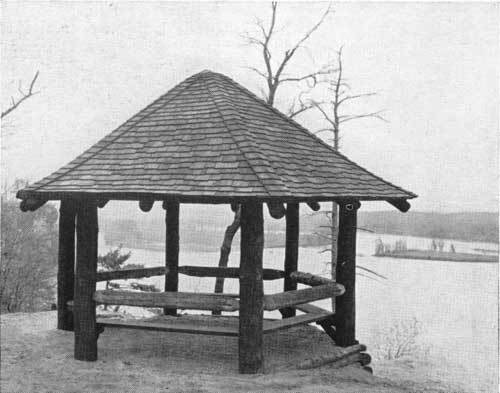
|
|
MUSEUM, MARIPOSA GROVE OF BIG TREES, YOSEMITE NATIONAL PARK
A pioneer cabin of the region,
re-built to serve as museum. Here are all the theoretical good features
of the ideal log structure, universally known but seldom encountered in
one building—simple lines, excellent scale of logwork and shake
roof, and massive chimney of admirable masonry and good silhouette. A
cabin such as this must have been the original of the "home on the
range." Dwarfed in scale but not in merit by the huge trees, the
presence of this simple and unassuming cabin is not the wide target for
criticism that almost any other structure in so impressive a setting
would be.
|
Museum Building, Petrified Forest National Monument
With simple dignity, this building happily succeeds both in capturing the flavor of the architecture of the old Southwest and gesturing in direction of the contemporary. No mean attainment in itself, but with the added score of an orderly workable plan, successful beyond cavil. As the plan indicates, the administrative function is incorporated in this museum building.
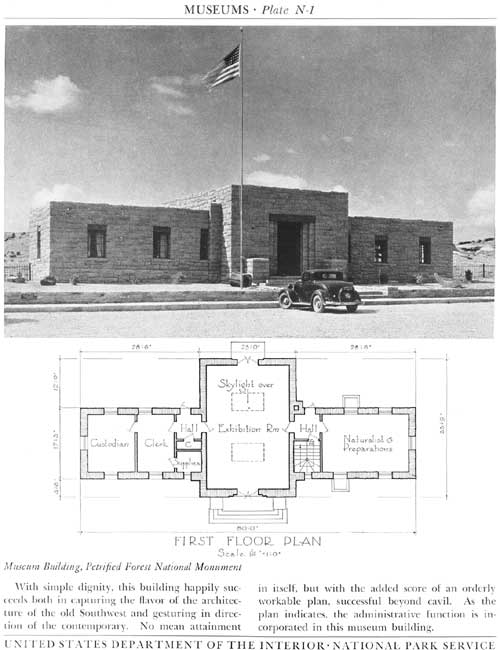
|
| Plate N-1 (click on image for a PDF version) |
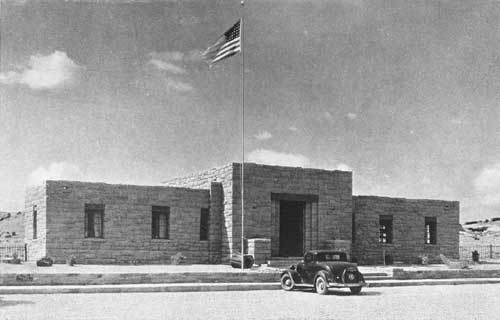
|
| Petrified Forest National Monument |
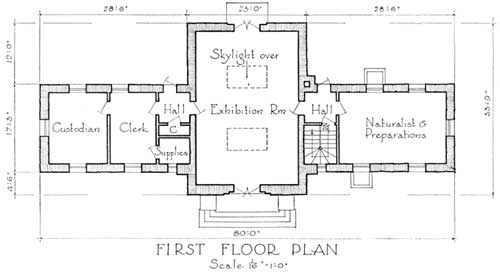
|
| Petrified Forest National Monument |
Nature Study Museum, Nitrate Plant No. 2 Reservation, Tennessee Valley Authority
Overlooking the Tennessee River, the paved terrace of this building offers a splendid view. The stone is buff in color, pleasingly varied. It is laid with a mechanical perfection that many will decry in a building dedicated to Nature and located in a natural area. It is regretted that authoritative explanation of the "card room" and "kitchen" shown on the plan cannot be offered. Possibly here is clever experimental widening of appeal to the public that will be more generally undertaken by museums in the future.
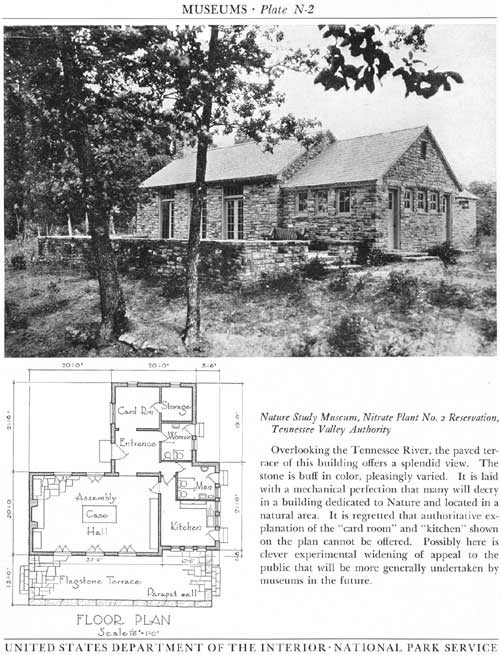
|
| Plate N-2 (click on image for a PDF version) |
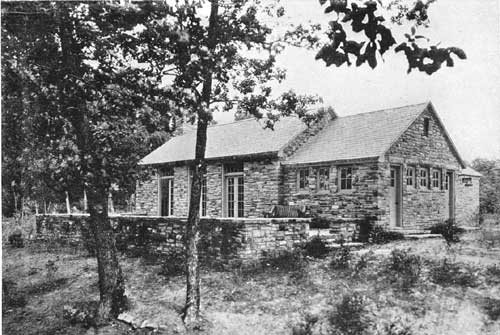
|
| Nature Study Museum, Nitrate Plant No. 2 Reservation, Tennessee Valley Authority |
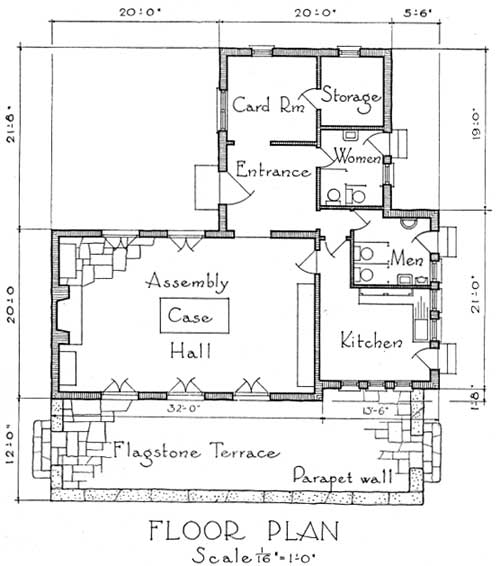
|
| Nature Study Museum, Nitrate Plant No. 2 Reservation, Tennessee Valley Authority |
Museum, Black Hawk State Park, Illinois
This museum was constructed to house an outstanding collection of American Indian relics. Although by no means expressive of such a collection in its architectural characteristics, the building has fine proportions and simple dignity. It can be argued that an unstyled structural interpretation such as this is to be preferred to a more obvious gesture in the direction of the civilization portrayed by the contents of the building. Its location near an urban area should go far to answer possible criticism of the somewhat finished character of the structure.
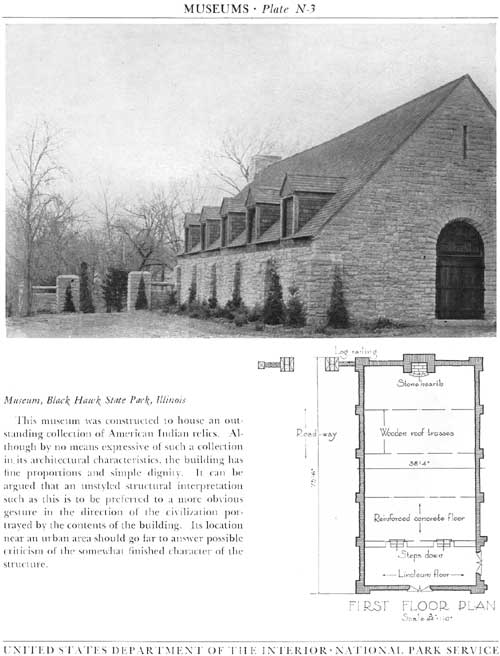
|
| Plate N-3 (click on image for a PDF version) |
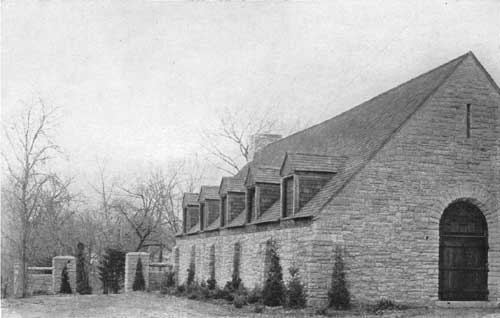
|
| Black Hawk State Park, Illinois |
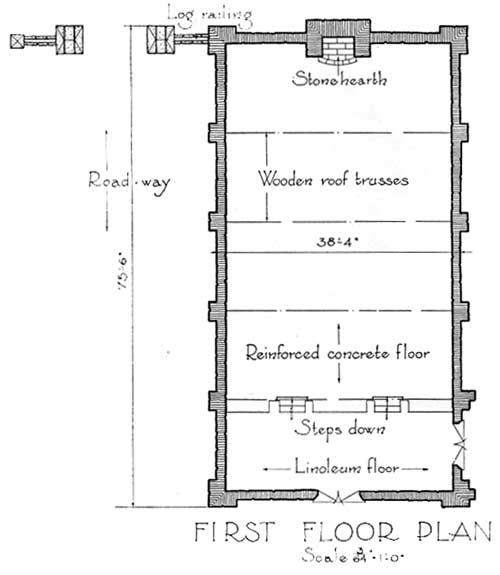
|
| Black Hawk State Park, Illinois |
Trailside Museum, Norris Geyser Basin, Yellowstone National Park
By its low horizontal lines this building gracefully insinuates itself into environment. Well-scaled to a rough mountainous region, and interesting by reason of irregularities of surface, are the logs selected. The shingles of the roof have adequate thickness, but might have been laid with more informality and consequent closer harmony with the bold log work and stone masonry.
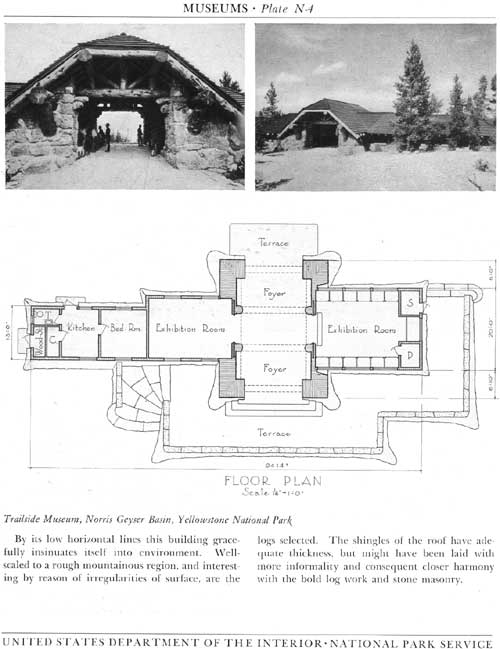
|
| Plate N-4 (click on image for a PDF version) |
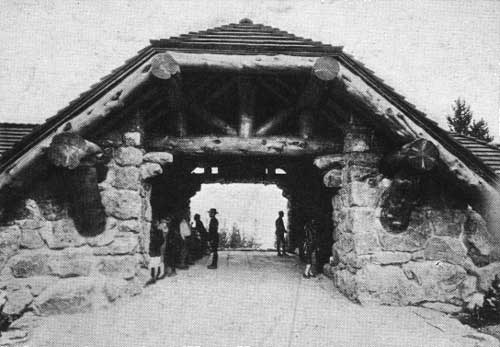
|
| Yellowstone National Park |
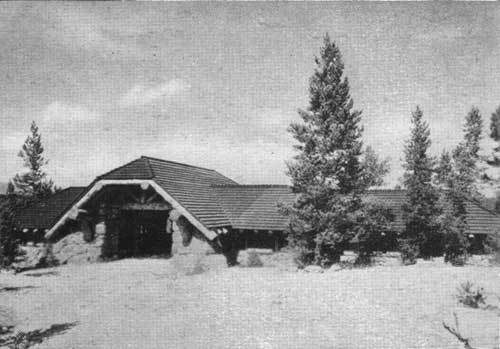
|
| Yellowstone National Park |
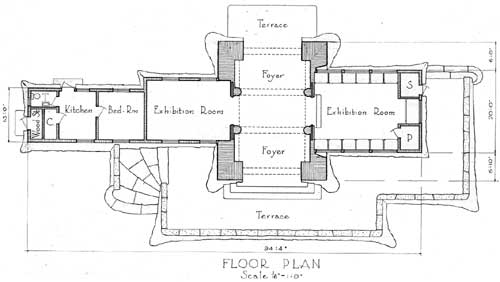
|
| Yellowstone National Park |
Museum Building, Madison Junction, Yellowstone National Park
Minor in size, but not in its contribution to park architecture. The pitch of the roof and the texture of the selected logs conspire with the rakish buttressing of the well-scaled rock work to deserve unqualified acclaim.
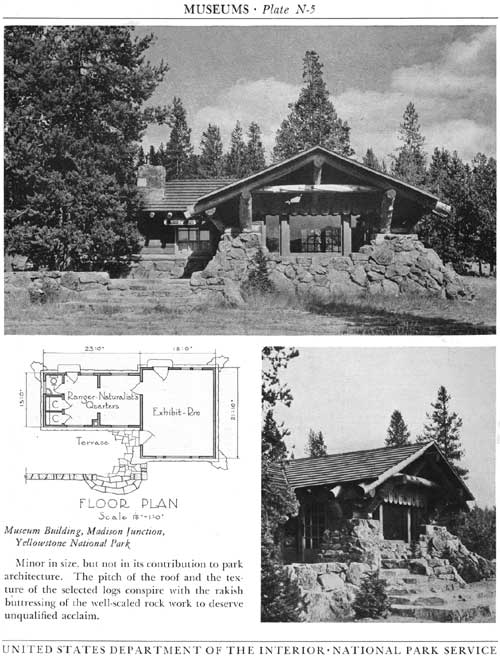
|
| Plate N-5 (click on image for a PDF version) |
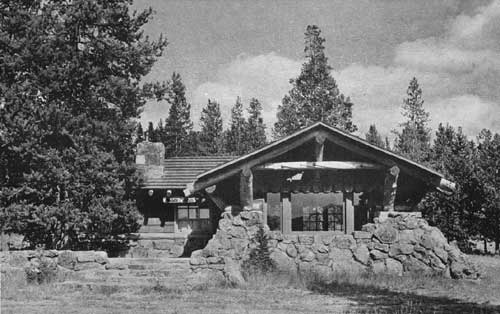
|
| Yellowstone National Park |
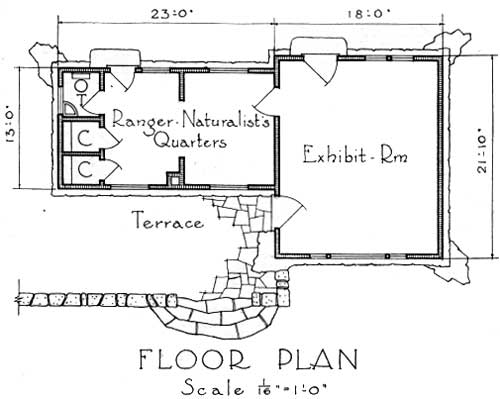
|
| Yellowstone National Park |
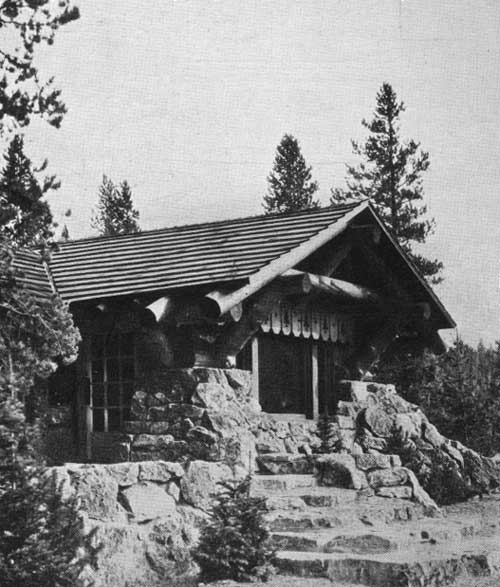
|
| Yellowstone National Park |
Fishing Bridge Museum, Yellowstone National Park
This well-planned and well-lighted nature museum is a successful example of the employment of principles important in the creating of buildings suitable to natural areas—among these the value of the freehand line, the avoidance of underscale, the pleasing quality of the furrowed and knotted log. The particular stone here used and its sweeping batter from grade to its meeting with the wood superstructure are agreeable details. On this page are the plan and a general view; on the opposite page a detail of exterior and an interior view showing arrangement of the exhibits.
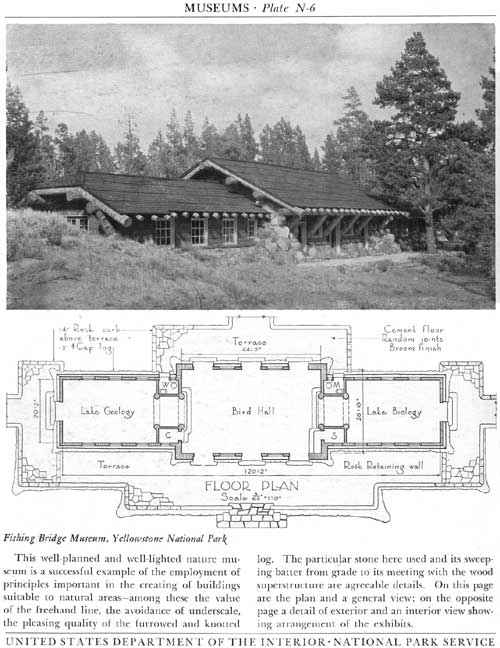
|
| Plate N-6 (click on image for a PDF version) |
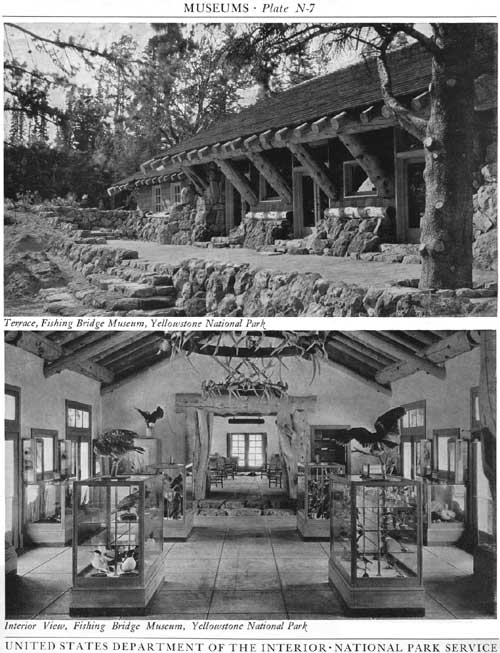
|
| Plate N-7 (click on image for a PDF version) |
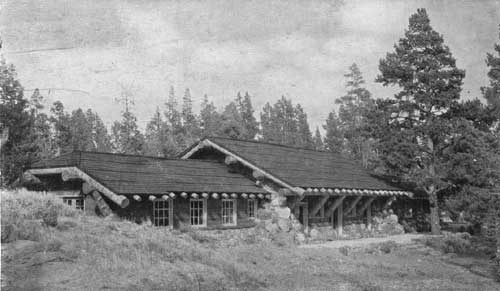
|
| Yellowstone National Park |
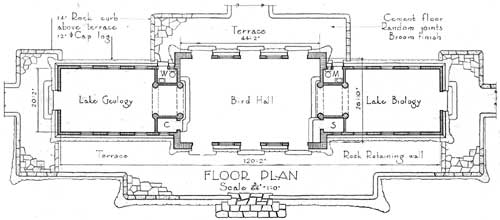
|
| Yellowstone National Park |
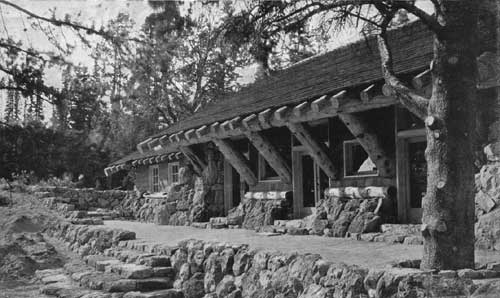
|
| Yellowstone National Park |
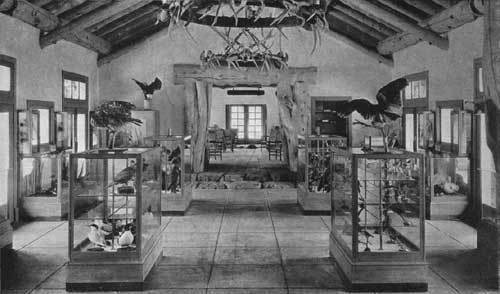
|
| Yellowstone National Park |
Trailside Museum, Bear Mountain State Park, New York
The contriving of this boulder masonry, perhaps because the structure is so low, does not have the degree of apparent instability, so lamentable in most attempts. The roof covering falls far short of complementing the massive walls. This is one of the earliest of the trailside nature museums that have lately attained great popularity in natural parks in far flung locations.
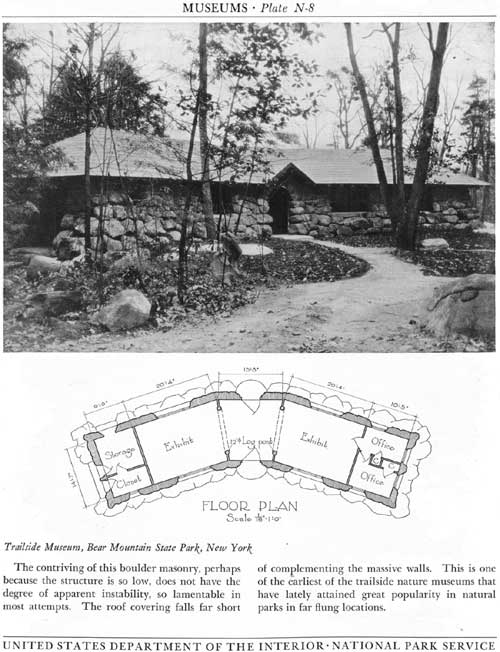
|
| Plate N-8 (click on image for a PDF version) |
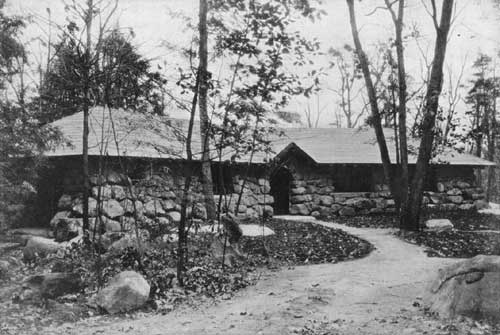
|
| Bear Mountain State Park, New York |
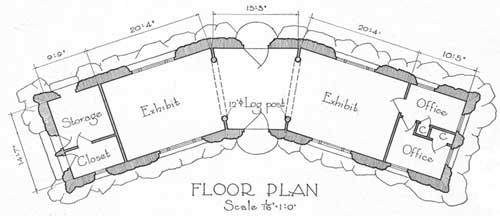
|
| Bear Mountain State Park, New York |
| <<< Previous | <<< Contents>>> | Next >>> |
park_structures_facilities/secn.htm
Last Updated: 5-Dec-2011